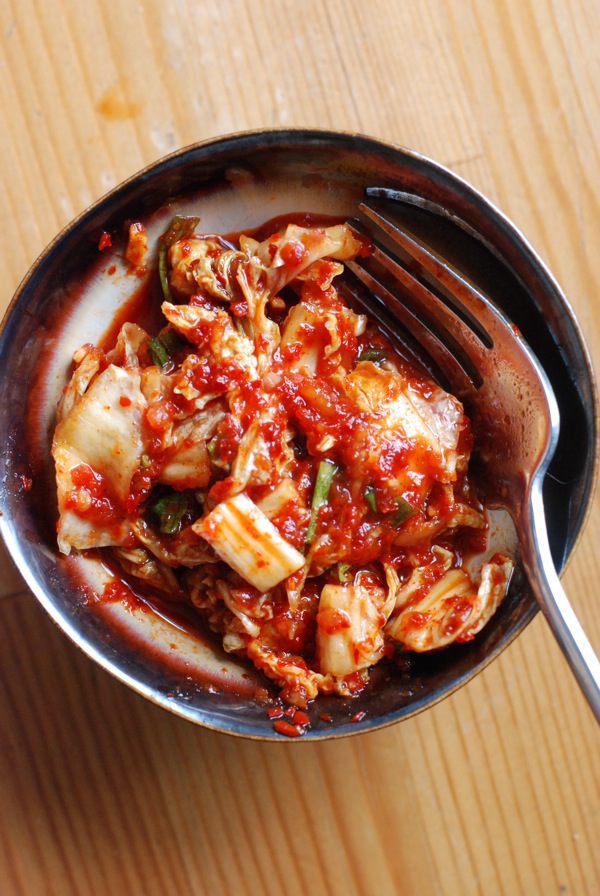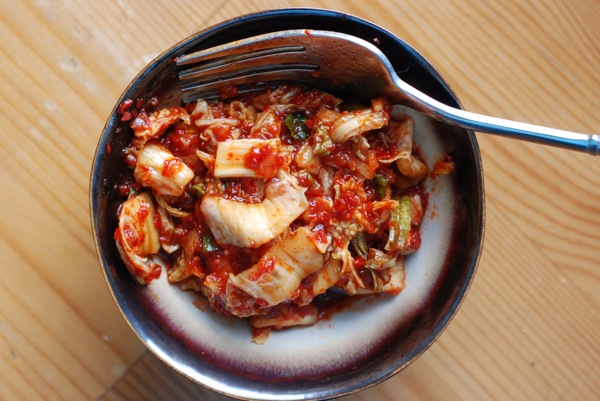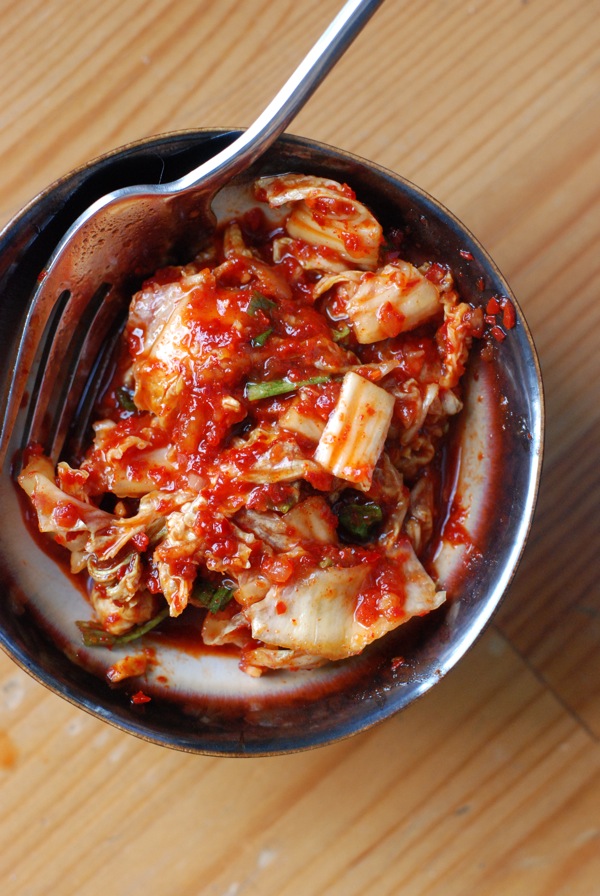 Sometimes, a post writes itself. As I was piling the big heap of pickled cabbage into my largest mason jar, I thought of all the times I'd pigged out on Kimchi in the past, all those times I'd been absolutely sure there was no way to make this stuff at home. I remembered the moment I'd received David Chang's Momofuku cookbook, how excited I was to discover that there was a recipe for kimchi -- a very easy, very doable recipe, involving no more than ten minutes of active prep time. I recalled how few recipes on this site are inspired by East Asia, how frustrated that's made me over the years, considering how prominently East Asian flavors figure into my home cooking and, to an even greater extent, my eating out. And I knew that as soon as work calmed down and Rosh Hashana had passed, I'd be telling you about this one-bowl dish that's quickly become a staple in my kitchen.
Sometimes, a post writes itself. As I was piling the big heap of pickled cabbage into my largest mason jar, I thought of all the times I'd pigged out on Kimchi in the past, all those times I'd been absolutely sure there was no way to make this stuff at home. I remembered the moment I'd received David Chang's Momofuku cookbook, how excited I was to discover that there was a recipe for kimchi -- a very easy, very doable recipe, involving no more than ten minutes of active prep time. I recalled how few recipes on this site are inspired by East Asia, how frustrated that's made me over the years, considering how prominently East Asian flavors figure into my home cooking and, to an even greater extent, my eating out. And I knew that as soon as work calmed down and Rosh Hashana had passed, I'd be telling you about this one-bowl dish that's quickly become a staple in my kitchen.
Like lacto-fermented pickles, the things that make kimchi so delicious are (mostly) environmental. Exposure to air and time turn the mixture of cabbage, chili, fish sauce, salt, and sugar into something much more intriguing than the individual components might suggest. Some of the kimchi I've had at restaurants has been overly pungent or funky, too sharply salty or sour, without proper balance. My favorite kimchi in the DC metro area, from the Annandale restaurant Ye Chon, is very good, but it sometimes lacks that hint of sweetness that balances the sour, salty, and spicy flavors and keeps your chopsticks coming back for more. Chang's kimchi gets that balance just right.
The most time-intensive part of this recipe is the shopping. If you don't already have fish sauce, you'll need to buy some. Don't be seduced by the tiny bottles they sell at Whole Foods; to make this properly, you'll need the stuff that comes in the big bottle (a bottle usually has between 3-6 cups worth). Yes, it's another thing to store in the fridge, and I get that that's a turn-off. And yes, I'm aware that fish sauce can smell like dirty socks. Have you already clicked away? No? I promise that kimchi reins in the funk of the fish sauce, and that the result will smell nothing like the locker room. My favorite fish sauce brands are Squid and Three Crabs, but anything you find at Hmart or an Asian grocer will be totally fine.
Another key ingredient is Korean chili powder, also called Kochukaru. I went to Hmart (the Asian grocery) in search of something by that name, and saw only pounds and pounds of "chili powder." Turns out, all the chili powder in the Korean aisle at Hmart is kochukaru. If you ask, the ladies behind the register will tell you it's what they use to make kimchi. You want the coarsely ground stuff. The last special ingredient is jarred salted shrimp, which I didn't use (I keep a kosher home, which means no shellfish). My kimchi was still delicious.
Other than that, we're talking basics. Cabbage, salt, sugar. Garlic and ginger. Soy sauce. Scallions and carrots round out the vegetables in this kimchi, and I've been known to dig to the bottom of the jar for some of those irresistible pickled scallion bits.
I've said before that my goal with this blog is convincing myself, along with you, that good food really isn't so hard to make. Yes, sometimes it requires ingredients that aren't exactly staples. Sometimes we end up needing to teach ourselves new tricks. But with one trip to the somewhat-obscure grocery store and a couple minutes of advance reading, something like kimchi -- which once seemed impossible to make at home -- can be in a mason jar, on your tabletop, in your mouth in practically no time. When good food is this simple, fear of cooking seems like a waste, doesn't it?
Kimchi Adapted from David Chang's Momofuku
1 small to medium head Napa cabbage, discolored or loose outer leaves discarded 2 tablespoons kosher or coarse sea salt (don't use table salt -- it's too harsh) 1/2 cup plus 2 tablespoons sugar 20 garlic cloves, minced 20 slices peeled fresh ginger, minced 1/2 cup kochukaru (Korean chile powder) 1/4 cup fish sauce 1/4 cup usukuchi (light soy sauce) 2 teaspoons jarred salted shrimp -- I didn't use this, and my kimchi came out great 1/2 cup 1-inch pieces scallions (greens and whites) 1/2 cup julienned carrots
Cut the cabbage lengthwise in half, then cut the halves crosswise into 1 inch wide pieces. Toss the cabbage with the salt and 2 tablespoons of the sugar in a bowl. Let sit for several hours or overnight in the refrigerator.
Combine the garlic, ginger, kochukaru, fish sauce, soy sauce, shrimp if using, and remaining 1/2 cup sugar in a large bowl. If it is very thick, add water 1/3 cup at a time until the brine is just thicker than a creamy salad dressing but no longer a sludge. Stir in the scallions and carrots.
Drain the cabbage and add it to the brine. Cover and refrigerate. After 24 hours, the kimchi will taste great. Don't eat it all right then and there, though -- it'll taste even better after a week of sitting, and at its prime 2 weeks out. It will still be good for another couple weeks after that, though it will grow stronger and funkier.

